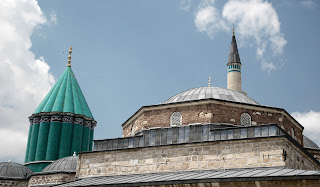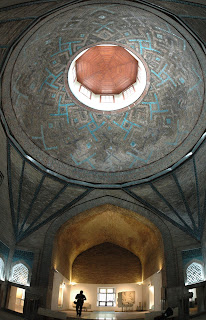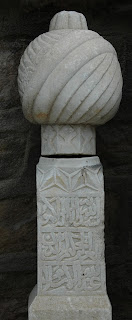Today, the Mevlana Museum. This is actually the original Mevlevi dervish lodge that was decommissioned when the Turkish government decreed in 1927 that all dervish lodges be closed. It still functions as a mosque, and all the earliest Mevlevi leaders are entombed here.
We won't try to give a history of Mevlevi Sufism — it's just too big a story. Instead you can read about the Mevlevi Order on WikiPedia or on their own official website, or even on this blog. But it follows the teachings of Mevlana Celaleddin-i Rumi (1207-1273).
The beauty of Islam (or perhaps it is one of its problems) is that no movement within it can be banned outright. The lodges may have been closed, but Mevlevi Sufism is as strong as ever, particularly here in Konya.
Their main ritual dance, the Semâ was not performed in public from 1927 until Mevlana Day, 17 December 1955, when the sema ceremony was performed both in Istanbul and in Konya, officially being a 'performance' (as it is now), but in fact it is most likely a genuine religious experience for its participants.
The Mevlana Museum is an incredible place, with tourists mingling with interested Muslims and also with devout Sufis. We watched a woman sitting opposite Rumi's tomb, praying intensely. And this is the way of it — whether a stranger to Sufism or one of its adherents, you cannot but respect Rumi and his philosophy. Pope John XXIII wrote in 1958: "In the name of the Catholic World, I bow with respect before the memory of Rumi."
The site, formerly the Rose Garden of the Seljuks Palace, was presented to Mevlana's father, Sultanü'l-Ulema Bahaaeddin Veled, by Sultan Alaeddin Keybuhad. The rose garden is still a feature of this site. Sultanü'l-Ulema was the first person buried on the site.
We explored the museum. Rumi is interred in pride of place, beneath the unmistakeable green dome, amidst the tombs of all the early leaders (Çelebi) of the order. There is always a large gathering before this tomb, praying or just giving respect.
We were able to see some of the treasures of the order — a 9th century Qur'an, the 1278 copy of Maṭnawīye Ma'nawī (Rumi's major work) prepared only 5 years after his death.
From the Mevlana Museum, we wen out, across the square outside where the huge mosque is currently closed for renovations, and went across to the Sufi Restaurant for lunch, where we had etliekmek (meat with bread, effectively a Turkish pizza) and küneffe for lunch, to the sound of Sufi music floating across to us from the museum. Most relaxing! . Even though the mosque opposite us was closed, this was no barrier for a number of men who wished to pray there!
The cells round the courtyard have been put to displaying different facets of Mevlana Sufism — their music, calligraphy, dress, and so on. Some have been set up to show the interior of the cells of different menbers of the order, and the kitchen area, where new initiates were taught the ways of the order, has models displaying just that — from where a novice had to undergo the ordeal of sitting on the pelt, to his later working in the kitchen, learning the twirling movements of the dance, and fully understanding the philosophy of Rumi.
From the Mevlana Museum, we wen out, across the square outside where the huge mosque is currently closed for renovations, and went across to the Sufi Restaurant for lunch, where we had etliekmek (meat with bread, effectively a Turkish pizza) and küneffe for lunch, to the sound of Sufi music floating across to us from the museum. Most relaxing! . Even though the mosque opposite us was closed, this was no barrier for a number of men who wished to pray there!
We then walked towards Alâaddin Hill, where there is one of the earliest and most important mosques on Konya. On the way, we passed the Şerafettin Mosque.
Then we went over to Alâaddin Hill, and the Alâaddin Mosque. This is in the throes of renovation, so we could see very little of it, but its interior has elements of Byzantine, Seljuk and Ottoman architecture. Around the mihrab (the niche indicating the direction of Mecca) are elements of all three. The minbar (pulpit) is exquisitely carved from solid ebony, with verses from the Qur'an on one side, and a listing of donors on the other.
From here, we went down to an old mosque that has now become a museum of stone and wood carving. Many of the exhibits here came from excavations on Alâaddin Hill.
Coming out, we got caught up in an election rally. The President of Turkey, Recep Erdoğan, is here today, drumming up support for tomorrow's election.
We got back to the van, finding it hemmed in by cars and buses here for the election rally. But no matter - we were remaining in the area to go to a sema performance at the nearby Mevlana Kültür Merkezi (Mevlani Culture Centre).
So, in the evening, we were treated to an evening with the whirling dervishes! The Sema is a combination of dance and music, and is has a very definite structure. Sufi music is very introspective, somewhat reminiscent of Japanese shakuhachu music.
After a most interesting evening, we drove back to the campsite, on te way picking up a couple of chops for Turka, the campsite's stray puppy!
Distance driven — today, 10 miles ( 17 km ); to date, 21,599 miles ( 34,761 km )















































Wonderful poet, wonderful Persian influences, wonderful everything. Glad Turka got his meat. What about a worm tablet or two for him? What do the Turks use? You'll never forget thee dervishes I reckon. i've always thought them amazing, but had no idea about all the rest. thank you. Love ya Cathy J
ReplyDelete